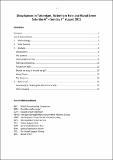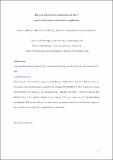Files in this item
The evolving normative dimensions of 'riot' : toward an elaborated social identity explanation
Item metadata
| dc.contributor.author | Stott, Clifford | |
| dc.contributor.author | Ball, Roger | |
| dc.contributor.author | Drury, John | |
| dc.contributor.author | Neville, Fergus | |
| dc.contributor.author | Reicher, Stephen | |
| dc.contributor.author | Boardman, Andrea | |
| dc.contributor.author | Choudhury, Sanjeedah | |
| dc.date.accessioned | 2019-05-06T23:37:19Z | |
| dc.date.available | 2019-05-06T23:37:19Z | |
| dc.date.issued | 2018-09-21 | |
| dc.identifier | 252193380 | |
| dc.identifier | 24ba0aae-09b9-4138-a35c-200275c2dbab | |
| dc.identifier | 85046643182 | |
| dc.identifier | 000445182800008 | |
| dc.identifier.citation | Stott , C , Ball , R , Drury , J , Neville , F , Reicher , S , Boardman , A & Choudhury , S 2018 , ' The evolving normative dimensions of 'riot' : toward an elaborated social identity explanation ' , European Journal of Social Psychology , vol. 48 , no. 6 , pp. 834-849 . https://doi.org/10.1002/ejsp.2376 | en |
| dc.identifier.issn | 0046-2772 | |
| dc.identifier.other | ORCID: /0000-0001-7377-4507/work/57568384 | |
| dc.identifier.uri | https://hdl.handle.net/10023/17650 | |
| dc.description | This research was funded by a grant to John Drury, Clifford Stott and Steve Reicher from the Economic and Social Research Council, grant number ES/N01068X/1. | en |
| dc.description.abstract | The question of how normative form changes during a riot, and thus how collective behaviour spreads to different targets and locations, has been neglected in previous research, despite its theoretical and practical importance. We begin to address this limitation through a detailed analysis of the rioting in the London borough of Haringey in 2011. A triangulated analysis of multiple sources of data (including police reports, media accounts, and videos) finds a pattern of behaviour shifting from collective attacks on police targets to looting. A thematic analysis of 41 interview accounts with participants gathered shortly after the events suggests that a shared antipolice identity allowed local postcode rivalries to be overcome, forming the basis of empowered action not only against the police but to address more long-standing grievances and desires. It is argued that collective psychological empowerment operated in a “positive feedback loop”, whereby one form of collective self-objectification (and perceived inability of police to respond) formed the basis of further action. This analysis of the development of new targets in an empowered crowd both confirms and extends the elaborated social identity model as an explanation for conflictual intergroup dynamics. | |
| dc.format.extent | 308847 | |
| dc.format.extent | 315416 | |
| dc.format.extent | 1587391 | |
| dc.format.extent | 3592216 | |
| dc.format.extent | 3441193 | |
| dc.language.iso | eng | |
| dc.relation.ispartof | European Journal of Social Psychology | en |
| dc.subject | Crowds | en |
| dc.subject | Social Identity | en |
| dc.subject | Empowerment | en |
| dc.subject | Collective conflict | en |
| dc.subject | 2011 English riots | en |
| dc.subject | BF Psychology | en |
| dc.subject | H Social Sciences (General) | en |
| dc.subject | 3rd-DAS | en |
| dc.subject | BDC | en |
| dc.subject | R2C | en |
| dc.subject.lcc | BF | en |
| dc.subject.lcc | H1 | en |
| dc.title | The evolving normative dimensions of 'riot' : toward an elaborated social identity explanation | en |
| dc.type | Journal article | en |
| dc.contributor.sponsor | Economic & Social Research Council | en |
| dc.contributor.institution | University of St Andrews. School of Psychology and Neuroscience | en |
| dc.contributor.institution | University of St Andrews. St Andrews Sustainability Institute | en |
| dc.identifier.doi | https://doi.org/10.1002/ejsp.2376 | |
| dc.description.status | Peer reviewed | en |
| dc.date.embargoedUntil | 2019-05-07 | |
| dc.identifier.grantnumber | ES/N01068X/1 | en |
This item appears in the following Collection(s)
Items in the St Andrews Research Repository are protected by copyright, with all rights reserved, unless otherwise indicated.





